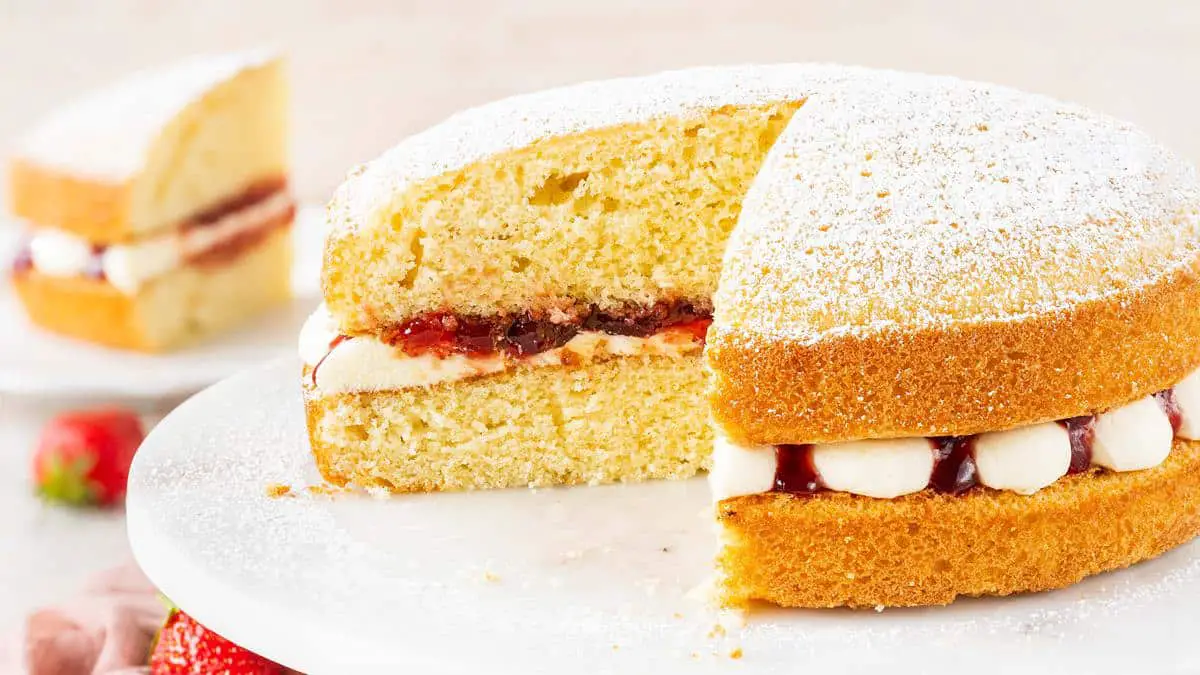The Victoria sandwich cake is a traditional British bake, that has to be a part of every baker’s repertoire! Two delicious vanilla flavoured sponge cakes sandwich layers of strawberry jam and smooth vanilla buttercream, with a simple dusting of icing sugar to finish. The Victoria sandwich cake is a fabulous in her simplicity but with stunning results. Perfect for birthdays, afternoon tea or indeed any celebration!

Is Victoria sponge cake British?
As you might suspect, the classic Victoria sponge was named after Queen Victoria herself. However, the tradition of afternoon tea as we know it today, actually began with Anne Russell, the 7th Duchess of Bedford. You see, back in the 19th century, the evening meal was taken between 8pm and 9pm. The poor Duchess complained of a “sinking feeling” around mid afternoon, so she requested some tea and light food was brought to help her stave off her hunger until the evening meal (or High Tea as it was then called).
Once this became part of her every day, she began inviting friends to partake in enjoying afternoon tea with her. Amongst those she invited to join her was none other than Queen Victoria herself. Once it had been given the royal seal of approval, this new tradition quickly rose in popularity amongst the upper classes, and the tradition of afternoon tea was born.
Queen Victoria was said to have rather a sweet tooth. Biographers have named a whole array of sweet treats she was said to have enjoyed, from cakes, petit fours, biscuits, tablets and many many more. However, this simple vanilla sandwich cake with jam and buttercream was always a favourite of hers, and so it came to be named after the monarch herself.
And a little extra British baking trivia for you!
Oh, and I love this little extra bit of trivia: on the much-loved baking show the Great British Bake Off, all the ovens are tested each and every day using a Victoria sponge. This cake serves as the benchmark to ensure all the ovens are working perfectly before the bakers enter the tent. Surely, if you needed any more reason to love this cake, that is it: surely it really is THE cake of the Great British Bake Off!
Why is it called a Victoria sandwich?
As established above, the cake itself was named after the infamous monarch, who rather loved the cake Victoria sandwich. The reason sandwich is sometimes used interchangeably with sponge or cake when describing this British classic bake is because it is always two layers of cake ‘sandwiching’ the fillings of jam and cream/buttercream.
Is Victoria sponge cake British?
Very much so! It originated in the UK, but the Victoria sandwich is now enjoyed the world over!
Is Victoria sponge the same as vanilla cake?
The two cakes have a lot of similarities for sure: they both have light vanilla sponges with a vanilla buttercream. However, a Victoria sandwich cake recipe will also include a jam in the filling, not just a buttercream.
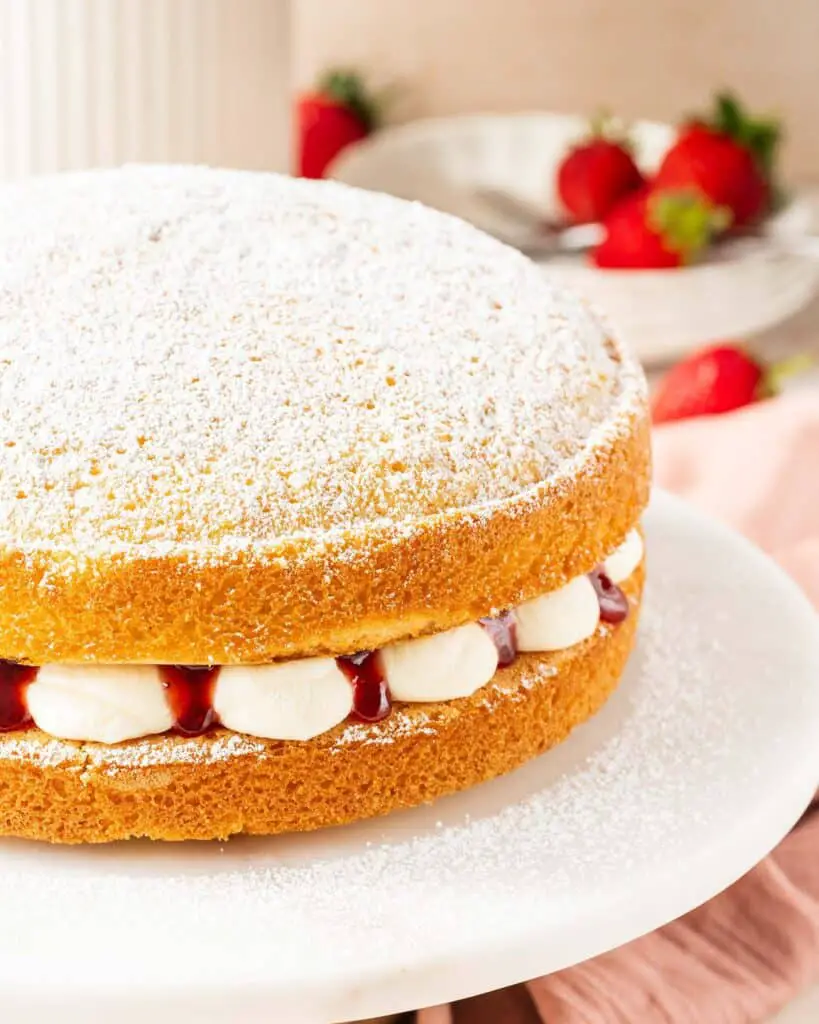
Victoria sponge cake ingredients
- Butter: I use unsalted butter so I can control how much salt is in the bake. Used in both the cake and the buttercream filling, always ensure it is at room temperature when making this best Victoria sandwich recipe.
- Sugar: caster sugar is used for sweetness in the sandwich Victoria and icing (powdered) sugar when making the buttercream, plus to dust the top of the cake.
- Eggs: gives structure and stability to the Victoria sandwich cakes as they bake.
- Flour: this recipe for a Victoria sandwich cake uses self raising flour along with a raising agent for ultra light and fluffy cakes. This is the traditional type of flour used when making this very British cake.
- Baking powder: the raising agent used in this traditional Victoria sponge.
- Vanilla: used in both the cake and the buttercream filling. Gives a wonderful flavour to this recipe Victoria sponge!
- Milk: just a little splash of milk is used in my recipe for Victoria sandwich cake to keep the cake moist and delicious and help make the buttercream silky smooth for piping.
- Jam: traditionally, a classic Victoria sponge cake will have raspberry jam in the middle. However, I have used strawberry here, both work beautifully in this cake!
What equipment do I need to make this Victoria sandwich cake recipe?
- Digital kitchen scales*: I always recommend using digital kitchen scales to weigh ingredients out over using a volume based measuring system, as cups. Weighing out the ingredients is much more accurate than measuring by volume, and will ensure better results in the cookies, so I would definitely take the plunge if you have not already.
- Measuring spoons*: for measuring smaller quantities such as tablespoons (tbsp) and teaspoons (tsp), a set of dedicated measuring spoons is a must! These are far more accurate than everyday eating spoons, and are really easy to get hold of too.
- Cake tins*: to bake the cakes in. I use two tins to make this best Victoria sandwich.
- Parchment/baking paper: to line the tins before baking the vanilla cakes in them.
- Mixing bowl*: to make the cake mixture as well as the buttercream in for this delicious simple Victoria sponge.
- Handheld electric mixer*: a super useful tool to make life easier in the kitchen! For me, essential to achieve a wonderfully light and moist Victoria sponge.
- Sieve*: to sift the dry ingredients before mixing in for the sandwich Victoria cake. Also used to dust the top of the cake with icing (powdered) sugar when finished.
- Jug*: I use a jug to mix together the eggs and vanilla before adding them in to make the cake batter.
- Spatula*: to scrape down the bowl with as ingredients are added, ensuring everything mixes together thoroughly. Also useful when making the buttercream filling.
How to make Victoria sandwich cake
I have spent years and years tweaking my recipe and method to be able to bring you the best Victoria sandwich cake recipe ever! Honestly, the real beauty of this cake is how simple she is to make! A basic vanilla sponge mix is brought together before baking in two tins, then simply sandwiched together with fluffy vanilla buttercream and delicious strawberry jam. Crown with a dusting of icing sugar for the perfect tea time treat!
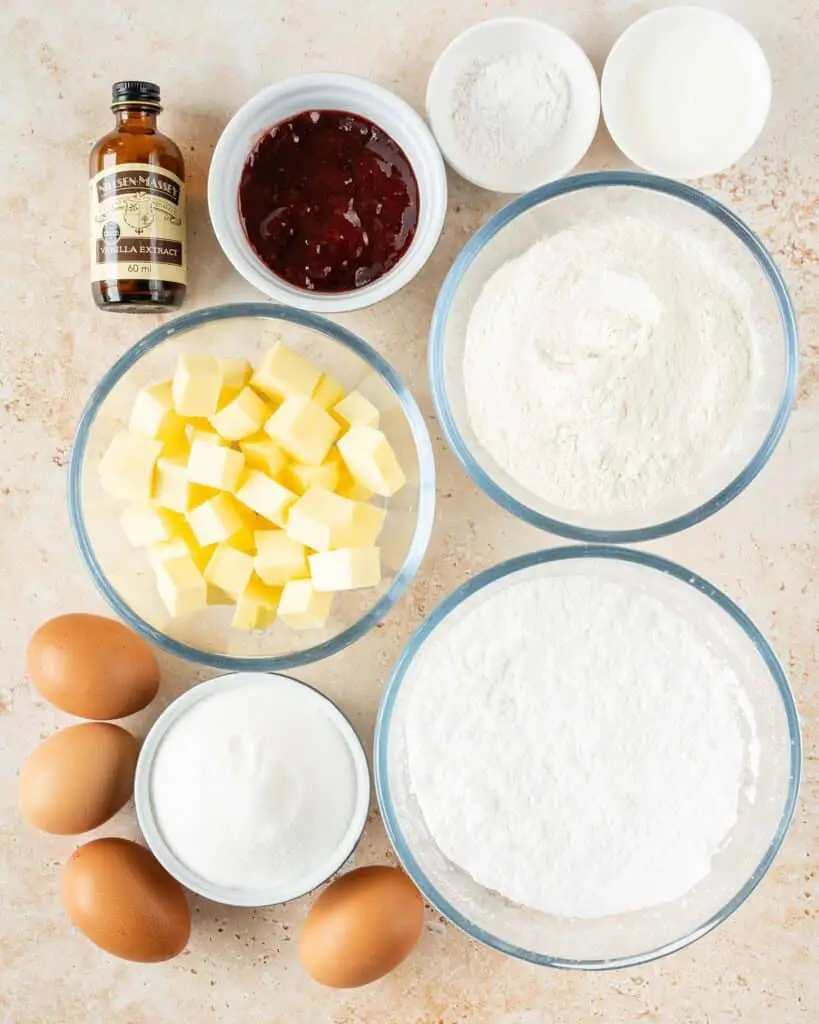
For the cakes
Step 1: Preheat the oven to 160C/320F. Grease and line two 8″ loose bottomed cake tins, then set these aside whilst making the cake.
Step 2: Beat the butter until soft and paler. Add in the caster sugar and beat until pale and fluffy, about 4-5 minutes.
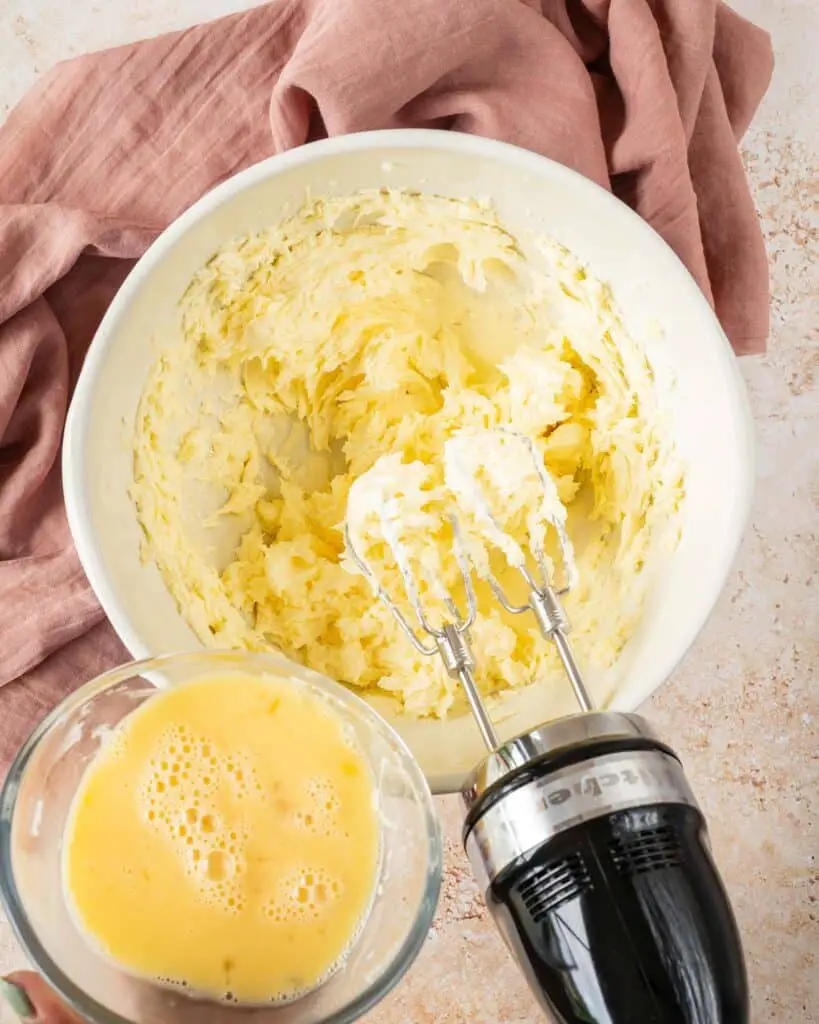
Step 3: In a small jug, beat all the eggs together. Gradually add the beaten eggs to the butter mixture, beating well between additions until all the egg has been added and the mixture is light and well mixed.
Step 4: Sift in the flour and baking powder. Fold this into the egg mixture until combined.



Step 5: Finally, tip in the vanilla and milk and fold in again until completely smooth and mixed through.
Step 6: Divide the cake mixture evenly between the prepared tins, then pop in the preheated oven and bake for 23-25 minutes until the cakes are golden, springy to touch and a wooden skewer inserted in the middle comes out clean. Allow to cool for five minutes in the tins before turning out onto a wire rack to cool completely.
For the filling and decoration
Step 1: To make the buttercream, beat the butter for 4-5 minutes until really pale and creamy. Tip in half the icing (powdered) sugar and mix to combine, then beat in the vanilla and milk until smooth. Add in the remaining sugar and beat slowly to mix in. Once combined, turn up the speed and beat on high until really pale, fluffy and soft. Pop into a piping bag, if using.
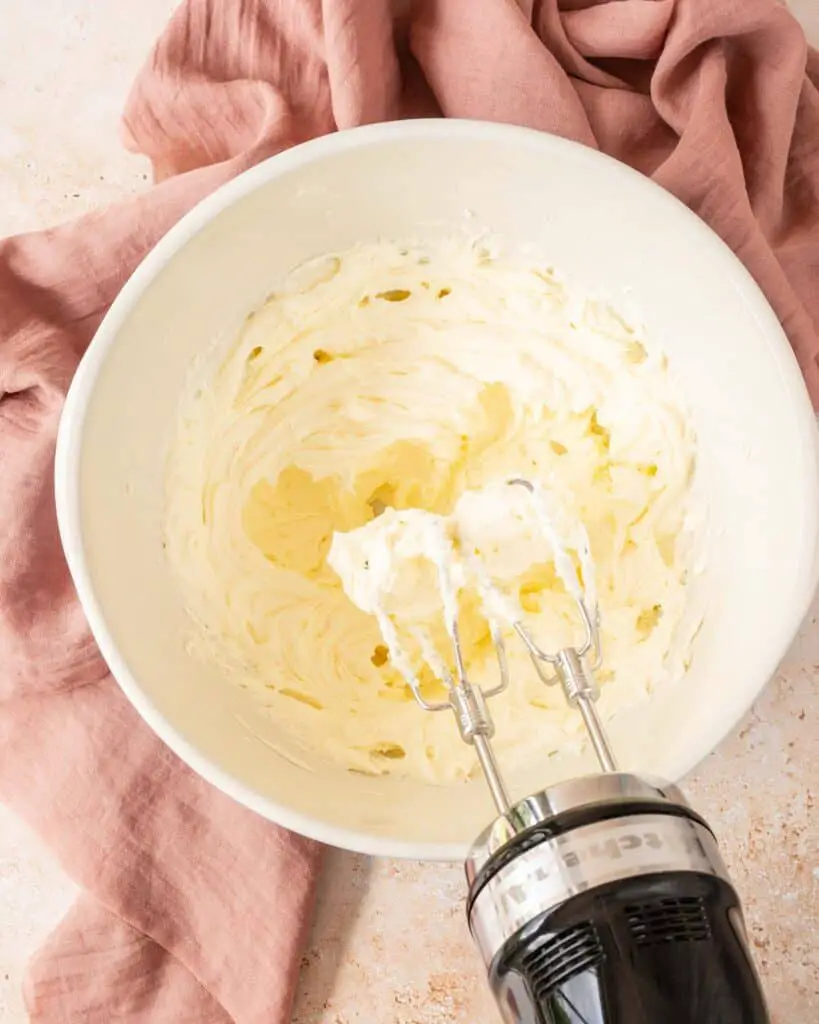
Step 2: Place the first cake on a plate or cake stand. Pipe or spread the buttercream in an even layer over the cake, creating a slight lip if you wish to hold the jam inside the cake.
Step 3: Give the jam a little stir to loosen it so it spreads more easily. Tip it over the buttercream layer and spread out evenly.
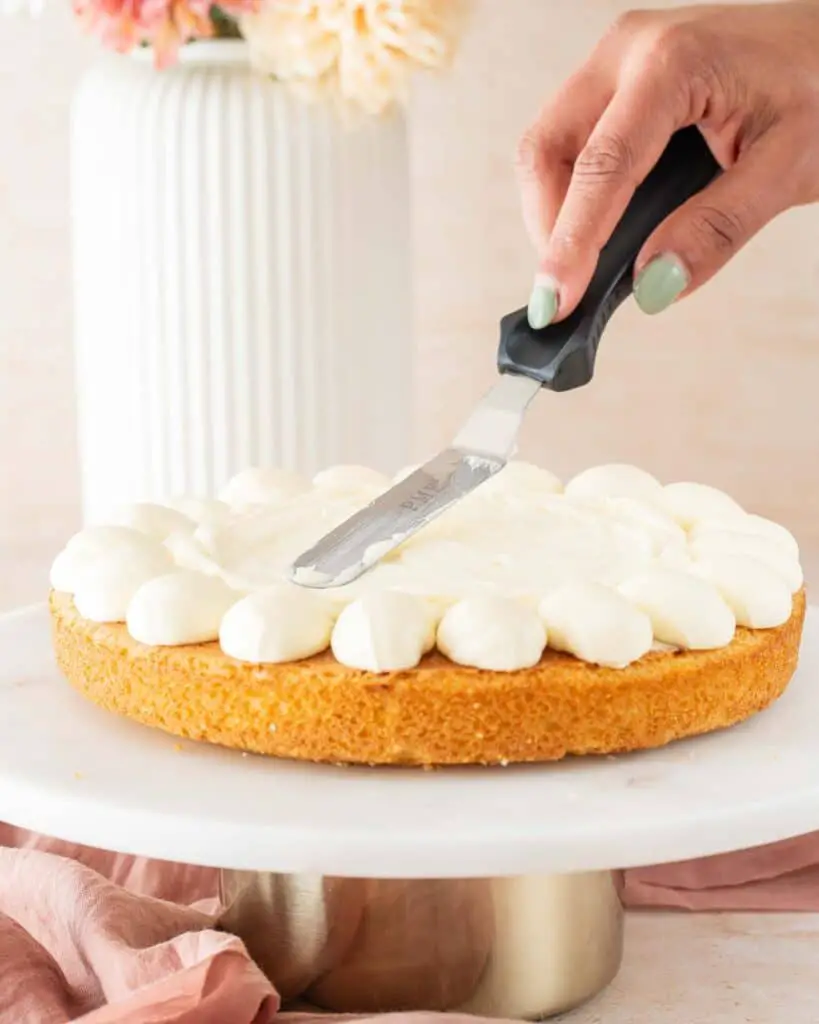

Step 4: Place the second cake layer over the jam, pressing very gently to encourage it to level the filling and sit flat on the fillings.
Step 5: Dust the top of the cake with a layer of icing (powdered) sugar before serving. Enjoy!

Is Victoria sponge raspberry or strawberry?
A classic Victoria sponge cake recipe would traditionally use raspberry jam, but strawberry jam does come a very close second and is what I have used in this cake!
Does Victoria sponge go with custard?
Custard is a staple pantry addition here in the UK, and in my opinion, absolutely yes! I think custard would go really well with a slice of my classic Victoria sponge recipe.
Why did my Victoria sandwich sink in the middle?
If you have used my Victoria sandwich recipe and found the cakes have sunk in the middle, there may be a couple of reasons why. Read on for just a few of the reasons:
- Underbaked cake. This is one of the most common reasons for your cake sinking in the middle. Always check for doneness by poking in a wooden skewer or toothpick into the middle of the cake. It should come out clean or with just one or two crumbs in. If there is more stuck to it, pop the cakes back in the oven for a few more minutes and test again,
- Oven temperature. If the temperature of the oven is lower than the recommendation, it will take the cakes longer to bake than the recommended time. It is also imperative to allow the oven to preheat fully before the cakes go in for the best results.
- Mixing the cake mixture. At the point the flour is added into the cake mixture, it should not be overmixed. Instead of using the beaters at this stage, I would suggest folding the dry ingredients through until entirely combined. This ensures the gluten from the flour is not overworked before it is baked.
How to store Victoria sandwich cake
Since this naked Victoria sponge doesn’t contain whipped cream in the filling, you can happily store it in an airtight container at room temperature. Always store in a cool place away from direct sunlight.
Can you freeze Victoria sponge?
Yes absolutely you can freeze this basic Victoria sponge! I would recommend freezing the cakes once baked but before decorated and assembled. After baking, allow the cakes to cool completely, then wrap tightly and securely in cling film and foil before storing in the freezer in an airtight container.
To thaw, simply remove from the freezer and unwrap before allowing to defrost completely on a wire rack. Once defrosted, fill and decorate according to the recipe.
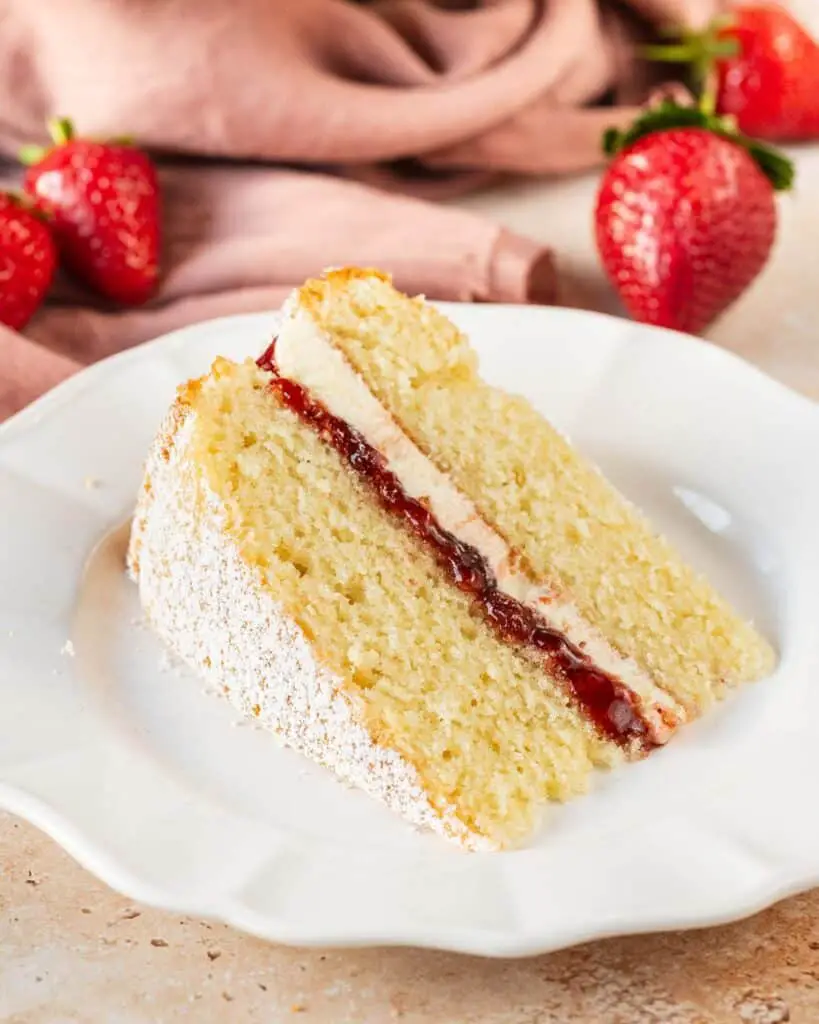
Tips and tricks for the best Victoria sandwich cake
- Use ingredients at room temperature when making the cake. The reason for this is simple: ingredients all at room temperature will combine better and make for a better bake! So this means the butter, eggs and milk should all be at room temperature before you start any mixing.
- Beat the butter well at the start of making the cake. You want it light and smooth and pale for the best results.
- Add the beaten eggs a little at a time to the butter mix. If you feel the mixture looks curdled at any point, simply add in a tablespoon of flour and mix through, then continue gradually adding in the eggs.
- Fold the dry ingredients into the cake rather than beating them in. This is to prevent over working the gluten, which will result in a tough cake texture.
- If you can’t find self raising flour where you live, you can substitute for plain (all purpose) flour with a little extra baking powder too. If using plain flour, use same amount of flour as per the recipe, but add an extra 2 tsp of baking powder to the mix.
- When making buttercream, working with soft (not melted) butter is key. Beating it up until pale and light and then adding the rest of the ingredients is pure magic!
- You can either pipe or spread on the buttercream. Try to create a little dam in the buttercream for the jam to sit in. This will help prevent it sliding out from within the cake, so you will always have all the jam waiting to be scoffed in the cake!
- Enjoy this cake within 2-3 days of making it for it to be at its best.
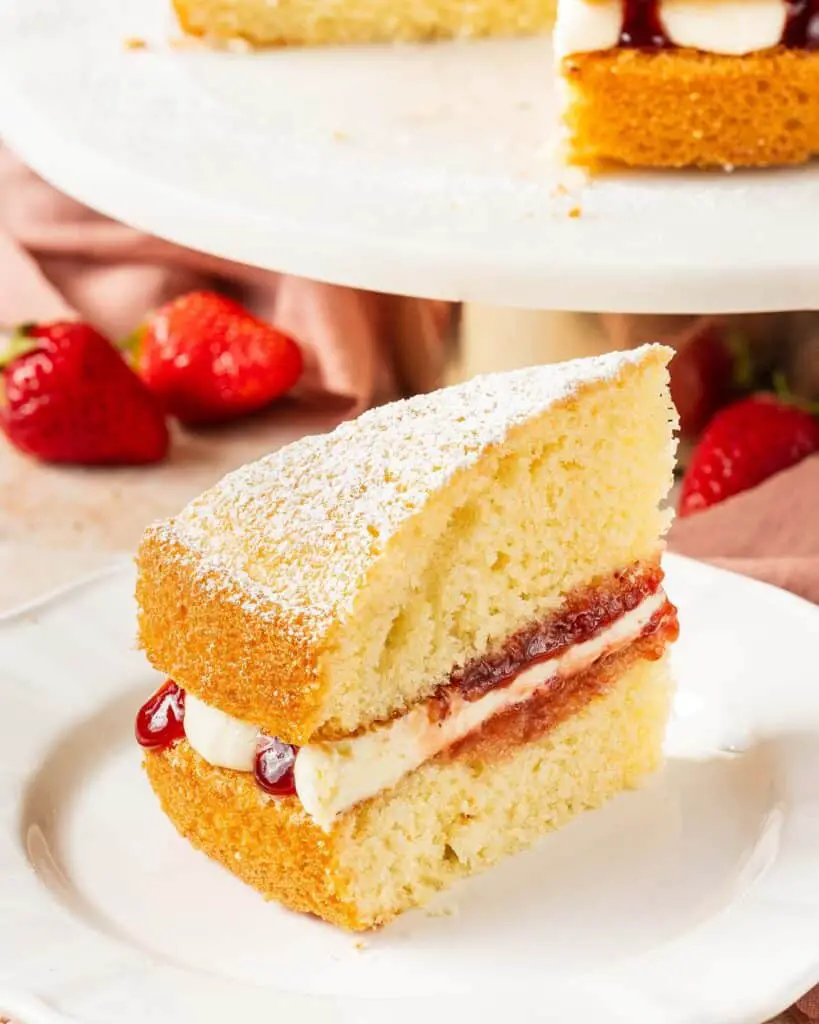
Troubleshooting
If you have any other questions about this easy Victoria sponge, please use the comments below and I will do my best to help. And if you do make this recipe for a Victoria sandwich, please dp leave a rating and review below. I would love to know how you enjoy it, plus it really helps others looking for a similar recipe too. You could even post a picture on Instagram and tag me when you share it with the world, you know I love seeing all your bakes!
More delicious British recipes for you to enjoy
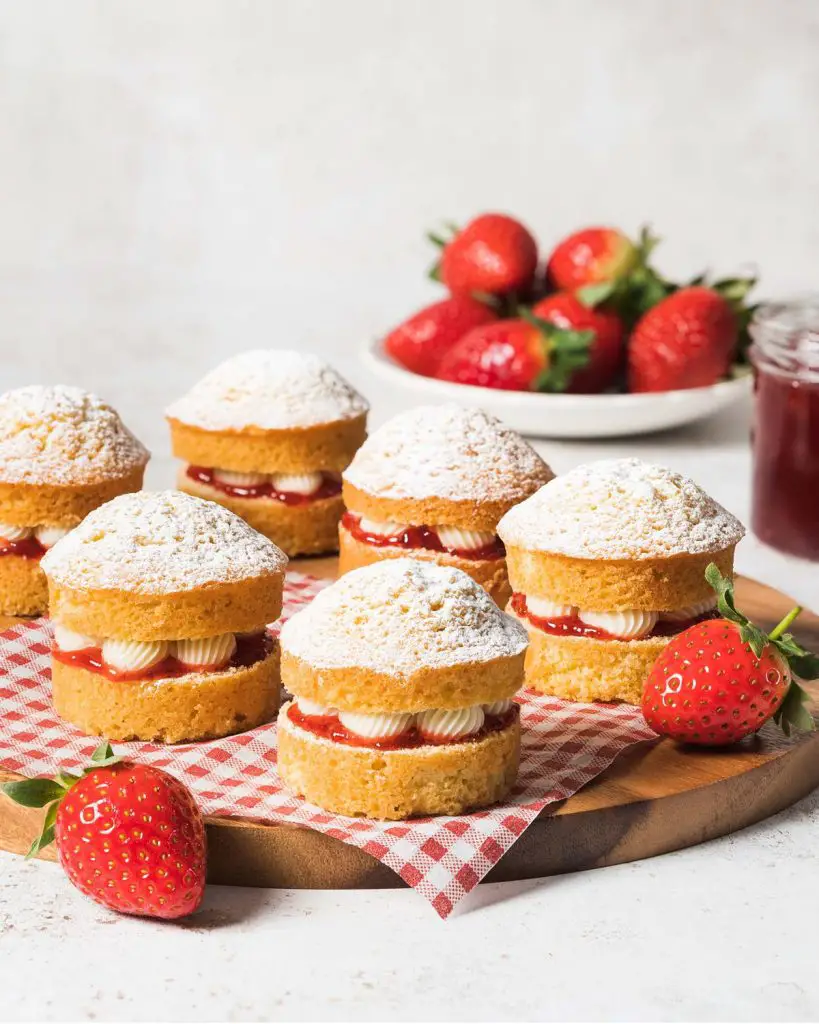
Mini Victoria sponge cakes. My mini Victoria sponge are a total winner every time! Light and fluffy vanilla mini cakes sandwiched with beautiful strawberry jam and delicious vanilla buttercream. They are so simple, but these Victoria sponge cup cakes are always enjoyed by everyone!
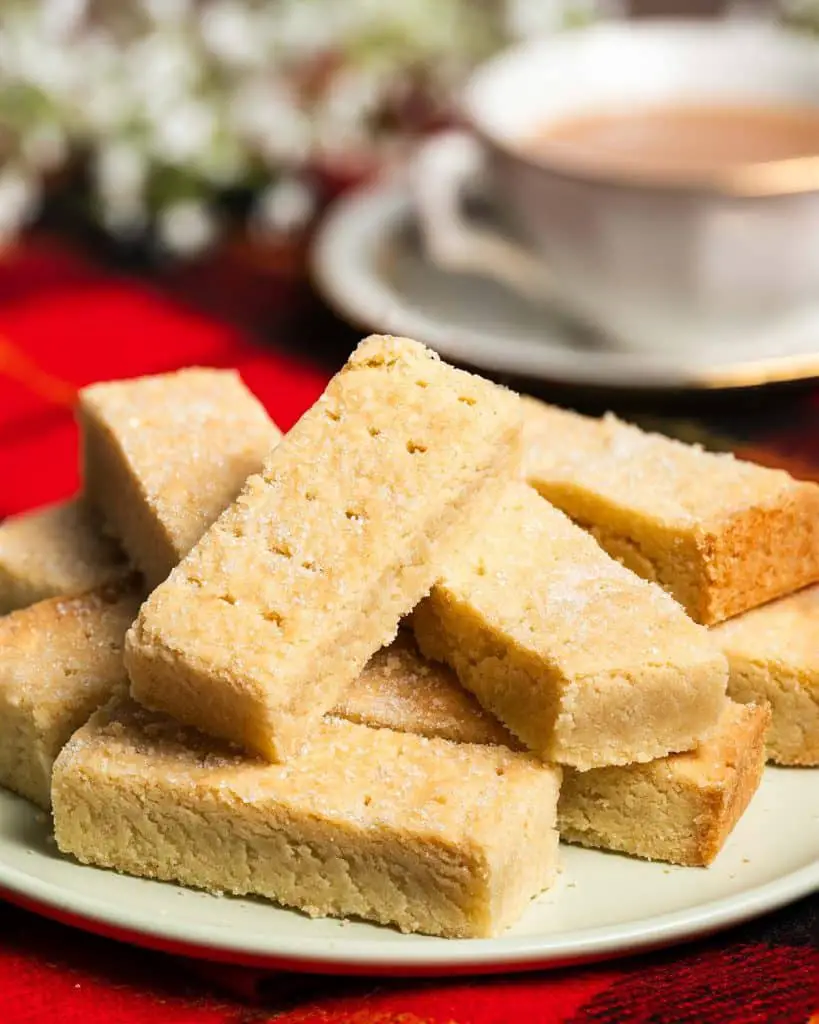
The BEST Scottish shortbread. This delicious Scottish shortbread recipe is one shared with me by a good friend passed down from her Scottish grandmother. It is hands down the best Scottish shortbread recipe you will ever try!

Mini cherry Bakewell tartlets. This mini Bakewell tarts recipe is the only one you will ever need for the perfect adorable bake. Beautiful buttery pastry, rich cherry jam, scrumptious almond frangipane. All topped with a layer of icing and, of course, the obligatory cherry on top!

Sticky toffee pudding. This beauty is light in texture, but it certainly does not lack anything else! This irresistible dessert is packed with dates and topped with a rich sticky toffee pudding sauce. Serve topped with a generous scoop of ice cream or lashings of custard or cream. The ultimate comfort food dessert!
And that’s all from me for today! Hope you enjoy making this beauty as much as I enjoy sharing with you. Happy baking, my friends! x
Recommended equipment I used *
| Digital kitchen scales | Measuring spoons |
| Cake tins | Mixing bowl |
| Handheld electric mixer | Sieve |
| Jug | Spatula |


